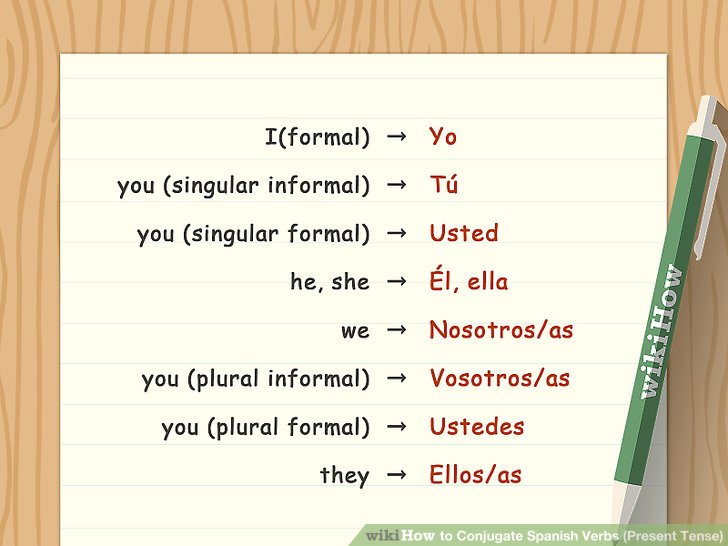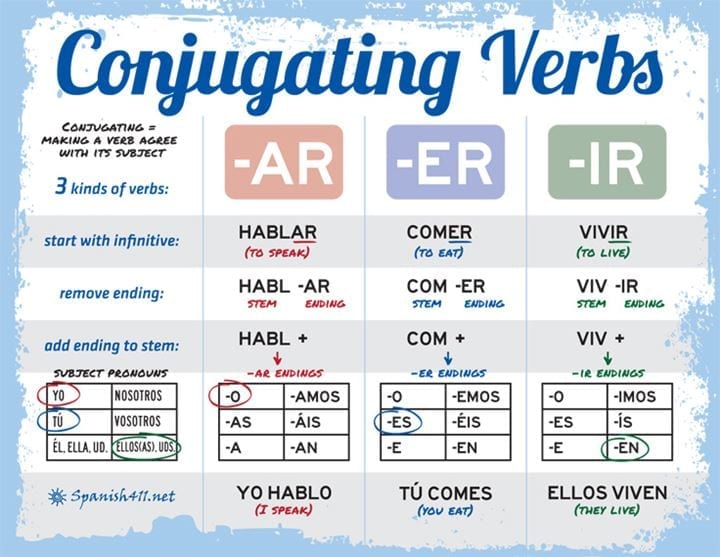ver means: to see
In this lesson we will learn how to conjugate the verb ver in the Presente tense of the Indicativo mood. It means we will see step by step how to get the following conjugation:
| yo | veo | I see |
| tú | ves | you see |
| él/ella/usted | ve | he/she/it sees |
| nosotros/nosotras | vemos | we see |
| vosotros/vosotras | veis | you see |
| ellos/ellas/ustedes | ven | they see |
This lesson is specifically about the ver verb conjugation. For an overview of Simple Tenses conjugation check our Simple Tenses Conjugation Chart.
You may also see the Video Presentation on how to conjugate verbs in Presente. It’s embedded on the right, but using the above link you may see more detailed information on conjugation in this tense as well as explanation of exceptions and special cases.
How to translate Presente to English
Notice that the phrases in English in the third column of the above conjugation table are not direct translations from Spanish to English. They are usually the closest general equivalents. The example differences are:- In Spanish, there is the form usted in the third person singular. But this person does not translate to the English third person singular. It translates to the so called formal you and uses the inflected form which is most often represented as he/she/it in English conjugation charts.
- Similar situation happens in the third person plural, where ustedes translates to the English plural formal you but uses the form which corresponds to the they form in English.
- Tenses are used differently in Spanish and English, so the actual translation should always take into account the context and focus on translating the meaning, not just words.
- In both languages each verb may have multiple meanings and not every meaning translates directly to the other language. Here also, the context and focusing on the particular meaning helps to create the most accurate translation.
The Spanish Presente de Indicativo tense translates to one of the following:
- The English Present tense, for example: usted ve(formal) you see
- The English Present Progressive (a.k.a. Present Continuous) tense, for instance:ahora ellas ven(feminine) they are seeing now
However, the Spanish equivalent of the Present Progressive also exists and is in common use – that’s Presente Progresivo (or Presente Continuo).
Note the timeline
The ability to properly locate the intended position on the timeline is a crucial skill for proper use of tenses. So note the timeline in our lessons and visualize it while listening, speaking, reading or writing. After a bit practice you will be capable of selecting the right tense to use much easier.
Step by step instructions
| Presente belongs to the simple tenses group, which means that all of the inflected forms are one word long. There are also compound (compuesto) tenses in Spanish language, where each inflected form consists of two words. The verb ver has an entirely regular conjugation in the Presente tense of the Indicativo mood. It means this verb just follows the general rules for its group (-er) without any exceptions, spelling corrections and the like. |
| The basis for this conjugation is the stem of the verb, so we have to start by splitting the infinitive into a stem and an ending. It’s really easy to do. Just remove two letters from the end of the infinitive form to get the ending — one of -ar, -er or -ir. What’s left is the stem. So for our verb:
|
| Use the stem v- in each subject as the basis for the conjugation, the common prefix or root that each of the forms begins with. |
 | Next, add to this regular stem the endings specific to each person. Analyze the image showing all six endings. Note both the colors and shapes of the letters. They are arranged to help you find patterns and make it easier to remember these endings. Each grammatical person has a specific ending in each of the three conjugation groups -ar, -er, -ir. |
The first person singular is irregular in this tense and needs to be memorized. It is veo:
|
Add the regular ending -es for the second person singular to create ves:
|
And again add the regular ending -e for the third person singular to create ve:
|
And again add the regular ending -emos for the first person plural to create vemos:
|
The second person plural is irregular in this tense and needs to be memorized. It is veis:
|
Also as in the previous case add the regular ending -en for the third person plural to create ven:
|
This is it! The conjugation is now complete. But don’t end your session yet – it is very important to repeat and practice the material in order to remember it. Check below for example phrases and some links.
Example sentences
¿Ves aquel ramo de hermosas flores púrpuras?
Do you see that bouquet of beautiful, purple flowers?
Cuando miro a mis compañeros veo la duda en sus ojos y eso me hace dudar a mí.
When I look at my colleagues I see the doubt in their eyes and that makes me doubt myself.
Siempre está cocinando cuando la veo.
She is always cooking when I see her.
Next Steps
- To practice this conjugation and test your skills try this Conjugation Exercise or the Memory Game
- For exercises and examples related to ver visit our Exercise section
- To see conjugation charts in all tenses for ver visit the Conjugator
- To explore other learning materials visit the Study section





